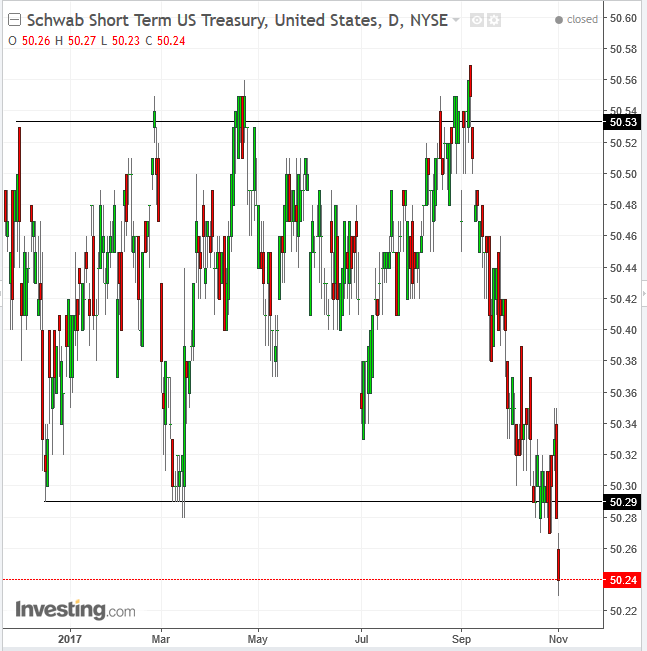by Pinchas Cohen
The presumed nomination of Jerome H. Powell as the 16th Chairman of the Federal Reserve is expected to have an impact on markets. In this piece, we will briefly discuss the likely effect.
The dollar began a reversal on the prospect of tax reform, and received a boost from the outlook of a more hawkish new Fed leader. The nomination going to Powell, a dovish choice who could almost be Janet Yellen II, would take away any anticipation for a faster pace of interest rate hikes, therefore diminishing dollar demand. Meanwhile, tax reform is facing considerable opposition by special interests, likely resulting in a postponement. While it is scheduled to be released today, it isn’t clear how many of the initial promises will be maintained, and for how long.
While the dollar appears to have completed a reversal pattern, we have seen warnings from day-one when we were not satisfied with the completion’s integrity and cautioned of a bull-trap. However, the line-in-the-sand marking the point of pattern completion has been crossed. Although it may turn around, we dare not oppose the presumed course of the storm. Therefore, we will address another asset, whose effect we usually expect to be the same as that of the dollar: Treasury yields.
First, we need to understand the inverse relationship between the price of a bond and the yield it pays.
The classic long-term investor, who buys a bond until its maturity, does so for its yield, or the interest rate it pays out. Enter bond traders.
What may have started as a response to “opportunity cost” (as market interest rates change, better yields become available) has evolved into speculation, like any other market. Prices of bonds, like other assets, are determined by supply and demand. Therefore, when the balance tips to buyers, the bond price rises, but the yield does not. However, relative to the higher price the investor had to pay for the bond, the yield is rendered lower. On the other hand, when there are more sellers, the price falls as sellers seek willing buyers, rendering the yield higher relative to the lower price.
With USD In The Red, Why Are Treasuries Being Sold Off?
While the dollar fell on the news of a dovish Fed chair, bulls pushed it back up. Still, the greenback is in the red. Treasury yields, however, had the opposite reaction. While falling in early trading (as demand drove up the price, leaving a smaller difference between the price and yield) yields climbed back up and are in the green, as Treasuries are being sold off.
If you’re confused at this point, you should be. Didn’t we say that investors sell Treasuries when interest rates rise, to take advantage of higher yields? Didn’t we also say that a dovish Fed chair is being nominated, suggesting a slower path to higher interest rates than might have been expected with the earlier, more hawkish front-runner? So, if interest rates are slowing down from the earlier outlook, why are investors selling Treasuries? They should be buying them! Well, it's because Treasuries also serve another purpose beyond providing a yield, namely, they act as a safe haven.
A more dovish Fed will boost the record-high stock market with lower interest rates and longer QE stimulus, making money cheap and abundant. Additionally, Powell comes from investment banking. He was the Vice President of Dillon, Read & Co, before he worked for the US Treasury. He is therefore perceived as sympathetic to the investing community and on the side of loosening profit-stifling regulations. Investors who bought Treasuries on fear of a market correction, or even a crash, may be rotating out of havens into the stock market.
The Short-Term Treasury Selloff

The Schwab Short Term US Treasury ETF (NYSE:SCHO) tracks the Bloomberg Barclays 1-3 Treasury Bond Index. It gapped down, providing a downside breakout of a key level where demand always supported the price, rendering the move a breakaway gap—a reliable continuation pattern, when everyone suddenly wants the same thing. In this case, that is to sell short-term Treasuries.
Apparently, the announcement of a dovish Fed chair suddenly turned short-term Treasuries burdensome on the support of buyers, who dumped off their load, joining the supply side. With their available cash, they can now buy equities.
Which stock should you buy in your very next trade?
With valuations skyrocketing in 2024, many investors are uneasy putting more money into stocks. Unsure where to invest next? Get access to our proven portfolios and discover high-potential opportunities.
In 2024 alone, ProPicks AI identified 2 stocks that surged over 150%, 4 additional stocks that leaped over 30%, and 3 more that climbed over 25%. That's an impressive track record.
With portfolios tailored for Dow stocks, S&P stocks, Tech stocks, and Mid Cap stocks, you can explore various wealth-building strategies.
